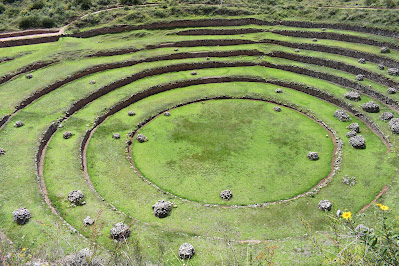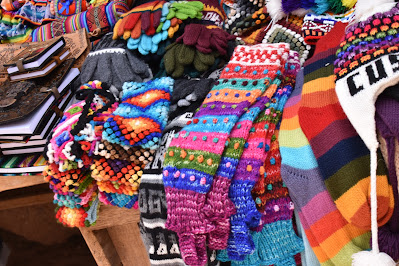Once we woke up our altitude sickness was for the most part gone so we decided to explore the Sacred Valley. Our first stop was at an alpaca wool shop where they held demonstrations on the process of weaving and dyeing the wool. We arrived at a quaint little workshop with a pen holding a couple of alpacas. The woman giving the tour was very nice and handed out cups of tea for everyone in the tour before starting the demonstration.
The first step is collecting the soft wool from the alpacas, once its been collected it has to be thoroughly rinsed in hot water to kill any parasites or pests nestled up in there. While they rinse they also straighten and thin the wool to the desired width. They then let the wool sit in dyed hot water for a few days. And you can vary the times to achieve the desired strength of the colour you want. Then using a spindle they bundle the wool into rolls which they use for the weaving and knitting. We also were able to see how the complicated weaving process that goes into making finer thread count items such as table runners.
Since the wool is so soft it makes for a really great sweatshirt so we purchased a few before our we had to depart for our next stop at the Moray ruins. We rode across the country side to one of the larger ruins in the area. The use for the ruins isn't agreed upon but it was most likely used for farming and perhaps the occasional ceremony or gathering. The ruins is a large circle indented down into the ground with many different terraces leading down to a field at the bottom. The temperature changes drastically from the top to bottom creating micro climates at each terrace. It has also been proven that the soil has been brought in from different regions so it suggests that they might have used these terraces to deduce which climates are best for growing crops although no one can know for sure.
After our stop at the Moray ruins we visited a salt mines of the Maras. These salt mines were created by the Inca some 2000 years ago and are still in use today. The methods they use now are basically the same as they were back then. The warm salt water is directed down narrow intricate channels that lead into the terraced pools. They let the water dry up in the sun as a thin layer of salt to be collected and stored. Then the process is repeated over and over. The pools themselves are nestled into a small valley with a beautiful mountain in the background.
There were small walkways along some of the pools so we were able to walk around and see the process in action. The sky was starting to darken and the lodge was still quite far away so we had to start on our way back.
The next morning after a late start we started our day by walking around the town of Pisac. We made our way through the winding streets and arrived at the largest street market I've ever seen. They sold all sorts of things varying from carvings, dolls, sweaters, toys, backpacks, fruits, purses, pottery, etc.
We wandered from stall to stall for at least two hours and we didn't even see more then half of the market. I ended up with a condor carving and a small alpaca wool backpack which I use to this day as a carry on bag for flights.
After checking out as much of the market as possible we took a hike up in the mountains. There were a whole bunch of ruins that resembled military bases over looking the town. The hike took a lot longer then we had expected which seems to be an ongoing trend for us after the incident in Cinque de Terre.
The trail led out at the market which is ironic cause we spent all morning trying to figure out which activity to do first. We grabbed a taxi and headed to Ollantaytambo for the night. The next morning we walked around Ollantaytambo for a few hours before catching a train to Machu Picchu. Once the train arrived it was too dark to see the mountains so we checked into our hotel room for the night.















No comments:
Post a Comment